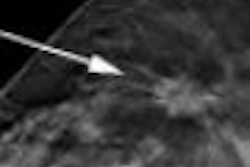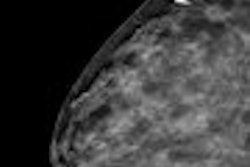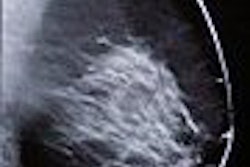Digital breast tomosynthesis (DBT) has become the next hot thing in breast imaging, with its potential to reduce recall rates in screening mammography, better detect abnormalities in dense breast tissue, and decrease the number of negative biopsies by improving the diagnosis of benign findings. But the technology is still under investigation, and no commercial units are on the U.S. market as of yet.
In a pilot study, researchers at the University of Pittsburgh and Magee-Womens Hospital, also in Pittsburgh, assessed ergonomic and diagnostic performance issues with interpreting DBT exams. Their work is published in the American Journal of Roentgenology (April 2008, Vol. 190:4, pp. 865-869).
Dr. Walter Good and colleagues gathered nine radiologists to read 30 cases under three different display conditions:
- Mode 1: Full-field digital mammography (FFDM) alone
- Mode 2: Eleven low-dose projections, or frames, taken for tomosynthesis image reconstruction
- Mode 3: The reconstructed digital breast tomosynthesis exam
The radiologists had between five and 35 years of mammography reading experience. The display conditions were counterbalanced, with three readers starting with mode 1, three starting with mode 2, and three starting with mode 3. Each of the 30 exams included two views of one breast, either the right or left craniocaudal and mediolateral oblique, and each was reviewed twice by an observer who knew the verified results. Five of the 30 examinations were negative.
By mode, the number of visible abnormalities found:
|
||||||||||||||||||||||||||||
The mean times in minutes over all readers and examinations are listed below:
- FFDM, 1.58 ± 1.07
- Frames, 2.03 ± 1.18
- DBT, 2.72 ± 1.44
The mean times in minutes to review, interpret, and rate the exams over all readers and modes were 2.03 ± 1.31 for nonmalignant exams and 2.52 ± 1.37 for malignant exams. Good and his team also found that the mean time spent in reviewing, interpreting, and rating the exams was different for different readers and modes but not for disease status.
None of the study's readers found the frames or DBT reconstructed image sets to be worse than FFDM images in any of the 30 exams reviewed, the group reported; three of the nine readers felt the frames were better than the FFDM exams, and six felt that the DBT exams were better than the FFDMs. Of the three different modes, the frames mode presented the most difficulty, which Good's team suggested could be due to the acquisition of each frame at a fraction of the radiation dose (about 10% of FFDM), which allows for more noise on the image.
The researchers made clear that their study is a preliminary one, noting that visualization tools and training need to be developed to help radiologists accurately interpret the multiple images DBT generates.
By Kate Madden Yee
AuntMinnie.com staff writer
April 18, 2008
Related Reading
Hologic edges DBT mammo system to market in Europe, March 26, 2008
ECR sessions examine DBT's effectiveness, March 7, 2008
Digital breast tomosynthesis boosts reader accuracy, cuts recall rate, December 28, 2007
Digital breast tomo cuts callback rate in screening setting, December 20, 2007
DBT: Not a panacea, but promising technology is unfairly panned, October 30, 2007
Copyright © 2008 AuntMinnie.com



















